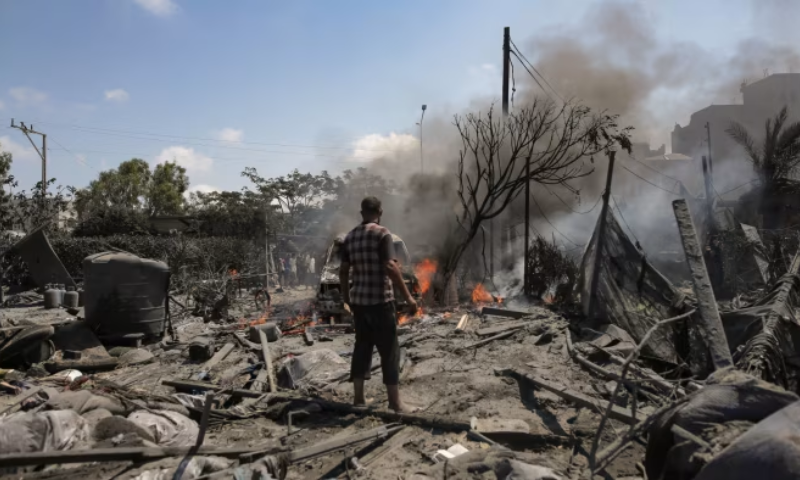The impact of Mohammed Deif’s death on Hamas and the Gaza Strip

About a day after news first emerged that Israeli forces may have assassinated Hamas military chief Mohammed Deif, there are still two conflicting aspects to the story.
On the one hand, the Israel Defense Forces, the Shin Bet (Israeli security service) and other defense officials tried to play it as if Deif was dead. Shin Bet chief Ronen Bar and Major General Yaron Finkleman, commander of the Israel Defense Forces Southern Command, took a joint victory lap through Rafah and discussed the importance of the targeted killing – a sign that they believed they had achieved their goal.
Likewise, the Chief of Staff of the Israel Defense Forces, Lieutenant General Herzi Halevi, was expected to make a public statement in which he would also address the attack on Deif.
Meanwhile, some details have leaked out from the Shin Bet after there were several confirmations that Deif was present at the scene of the attack and that he would not have survived due to the size of the munitions.
In addition, there was a view in Israel that Deif came out of the tunnels to get some air, as he was suffering from numerous health problems caused by his indefinite stay in the tunnels. Others said he came out believing that the hostage negotiations would grant him some temporary immunity.
In addition, there were photographic recordings of the crime scene before, during and after the attack, and there was no evidence that Deif had left the scene.
However, no body has been found yet and it is unclear whether there is any possibility of finding an identifiable person with such a large bomb and so many Palestinians killed.
Add to this the fact that Deif survived several physical attacks by Israeli forces, and that Hamas has not only remained silent on the issue but has issued several detailed and extensive denials, and the picture remains murky.
Is Hamas’ denial a sign of embarrassment?
On the Israeli side, there was a tendency to interpret Hamas’s denials in a condescending manner, thereby covering up how embarrassed it felt at a crucial moment in the ceasefire and hostage-taking negotiations.
Conflicting messages also came from Hamas. Some said Israel’s “aggression” meant a halt to talks, while others said Hamas was pushing for the talks to continue to show that it is in fact Israel that does not want a deal. The former head of intelligence analysis for the Israel Defense Forces, Brigadier General (ret.) Yossi Kuperwasser, said if Deif were killed, it could have even greater strategic implications than the killing of arch-terrorists such as Hezbollah military commander Imad Mughniyeh in 2008 or Iranian intelligence chief Qasem Soleimani in 2020.
Kuperwasser explained that many high-level terrorist leaders have been killed over the years and that some are easy to replace while others are more difficult to replace. Almost every terrorist will be replaced at some point, even if it is by someone with less talent.
The difference in the Deif case is that Hamas has now lost control of its base area and is in danger of being permanently downgraded from a terror group that once dominated the lives of 2.3 million Gaza residents to an even more inexperienced and smaller terror group, Kuperwasser said.
In other words, it is the combination of his position as the military mastermind behind Hamas and the terrorist groups’ desperate and urgent need to rebuild their military structure that could strategically derail a Hamas comeback.
On October 7, Hamas organized the Gaza Strip into 24 independent battalions, each with its own geographic jurisdiction, its own weapons and supplies, and its own communications, intelligence and tunnel networks.
Depending on estimates, Hamas has lost between 60 and 80 percent of its forces during this war, including the vast majority of its battalion commanders, three of its five brigade commanders for all of Gaza, and most of its senior rocket and drone commanders.
In this context, Deif would have been more important than ever, as he could retrain a new generation of commanders and align them with a more comprehensive strategy and structure.
Hamas may currently lack such an experienced military master strategist, and Deif’s two closest deputies are also dead.
Mohammed Sinwar, the brother of Gaza chief Yahya Sinwar, is expected to take power if Deif is indeed dead. But even if he had built an army, he would not be credited with anywhere near as much talent, let alone having to rebuild Hamas as a national force.
Unless Hamas succeeds in expanding its military network beyond the status of a guerrilla terrorist group, it will not be able to pose anywhere near the threat it has posed to Israel since it took control of Gaza 15 years ago.
Former Israel Defense Forces intelligence chief and current INSS director Tamir Hayman defended Deif’s killing despite the potential risk it could pose to ceasefire negotiations and hostage-taking.
For months he was a strong advocate of a hostage deal with Hamas, even at the cost of an indefinite pause in the war.
However, Hayman explained that killing a person at the level of Deif, the man who planned all the military tactics behind the October 7 invasion, was a crucial strategic imperative that stands on its own, independent of its other implications.
He also considered it possible that if Deif were killed, the remaining, ever-shrinking Hamas leadership would, over time, be more willing to release Israeli hostages in order to put an end to the hunt for them, at least temporarily.
The situation surrounding Deif is still largely overshadowed by questions.
But looking back, Saturday’s strike could ultimately be seen as one of the decisive strategic moments – not only of the war, but also of the competing visions for reshaping the post-war order in the region.



